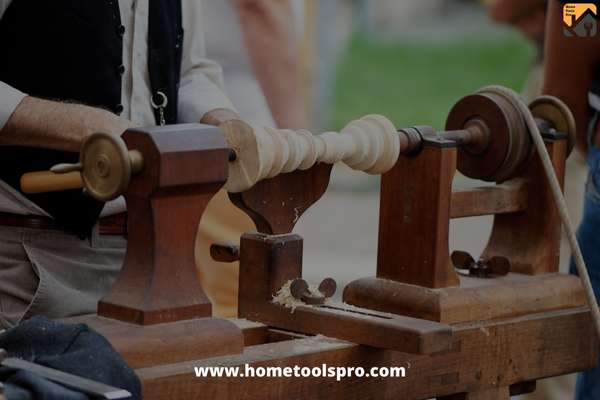Can really a Lathe Handle Heavy Wood?
A lathe is a powerful tool that can be used to create beautiful and intricate pieces of woodwork.
However, some people may wonder if a lathe can really handle heavy wood.
The answer is yes! A lathe can definitely handle heavy wood. In fact, many professional woodworkers use lathes to create large and sturdy pieces of furniture.
Lathes are designed to handle large pieces of wood, so you can rest assured that your lathe will be able to handle any piece of wood you throw at it.
However, you need to take the decision of the size of your wood piece based on the capacity of your lathe.
Kinds of Heavy Woods a Lathe Handles

As a lathe operator, you will be expected to handle all kinds of heavy woods. Here are some of the most common types of heavy woods that you will encounter:
Snakewood: With a density of 75.7 lbs/ft3, Snakewood is one of the heaviest woods in the world.
Its unique patterns and markings make it a desirable wood, but its limited supply means that it is also one of the most expensive.
Leadwood: This has a density of 75.8 LBS/ft3. Leadwood is one of the heaviest woods in Africa.
It is so dense that it is difficult to find and is protected in South Africa.
If you are looking for strong and heavy wood, leadwood is the way.
Quebracho: Quebracho has a density of 77.1 LBS/ft3.
One of the heaviest and hardest woods in the world, Quebracho is a species of tree native to South America.
The name “Quebracho” comes from the Spanish word “quebrar hacha,” which means “axe breaker.”
Dessert Ironwood: This wood is a hobbyist favourite with a density of 75.4 LBS/ft3.
Too small to be a viable timber tree, this wood’s colourful grain and high density are restricted to small specialty projects. Even so, it is a heavy wood that can be used for a wide range of applications.
Safety Tips when handling Heavy Woods on a Lathe

Working with heavy woods on a lathe can be dangerous.
Here are some safety tips to keep in mind when working with these materials:
- Always wear gloves when handling heavy woods. The gloves will help protect your hands from the sharp edges of the wood.
- Make sure that the area around the lathe is clear before starting to work. This will help prevent accidents if the wood should slip while you are working with it.
- Use a face shield or goggles to protect your eyes from flying debris.
- Use hearing protection to safeguard your ears from the loud noise of the lathe.
- Never reach over the top of the lathe while it is running. This could result in serious injury if the wood should slip or break.
- Always keep your hands clear of the cutting area. This will help prevent accidents if the wood should kick back while you are working with it.
- Use a push stick to feed the wood into the lathe. This will help keep your hands away from the cutting area and will also help to prevent the wood from kicking back.
- Always unplug the lathe before making any adjustments to it. This will help prevent accidents if the lathe should start while you are working on it.
- Make sure that the lathe is properly secured before working with it.
With these safety tips in mind, you will be able to work with heavy woods on a lathe safely and effectively.
Visual Explanations: https://www.youtube.com/watch?v=EOzYJ2pn2B0
How do you determine the Maximum Weight of Wood pieces a Lathe can handle?
This is an important question to ask when you are working with a lathe.
The maximum weight that a lathe can handle will vary depending on the type of lathe and the manufacturer.
You will need to consult your lathe’s manual or contact the manufacturer to determine the maximum weight that your specific lathe can handle.
When you are working with a lathe, it is important to keep in mind that the weight of the wood piece that you are working with will affect the speed and stability of the lathe.
If you are working with a heavier piece of wood, you will need to use a slower speed setting on your lathe.
This will help prevent the wood from becoming unstable and possibly breaking while working with it.
It is also important to note that the maximum weight that a lathe can handle will vary depending on the type of wood that you are working with.
Softer woods, such as pine or cedar, will be easier to work with than harder woods, such as oak or maple.
This is because softer woods are less likely to cause the lathe to become unstable at higher speeds.
It is always best to err on the side of caution when you are working with a lathe.
If you are unsure about the maximum weight that your lathe can handle, it is always best to contact the manufacturer for more information.
This way, you can be sure that you are not putting too much strain on your lathe and potentially damaging it.
Visual Explanations: https://www.youtube.com/watch?v=JLtUdHAkKTQ
What if you go overweight on the Headstock & Tailstock of a Lathe?
If you’re working with a lathe, it’s important to ensure that the headstock and tailstock are properly aligned.
If you don’t, you could put too much force on one side of the machine, which could cause the entire thing to tip over.
If you do happen to go overweight on either the headstock or tailstock, you can do a few things to correct the problem.
First, try moving the centre point of gravity closer to the centre of the lathe.
This will help distribute the weight more evenly and make it less likely for the machine to tip over.
If that doesn’t work, you may need to add extra support to the headstock or tailstock.
This could mean adding a second support column or using a heavier-duty stand.
Whatever you do, make sure that the additional support is durable and won’t add any extra risk of tipping over.
With a little bit of care, you can avoid going overweight on the headstock or tailstock of your lathe.
By ensuring that the machine is properly balanced, you’ll be able to work more safely and avoid any accidents.
How can a Lathe Break Down?

A lathe is an important tool in any machinist or woodworker’s arsenal.
It is a versatile machine that can be used to create a variety of parts and products. However, like all machines, a lathe can break down.
There are several different ways that a lathe can break down.
The most common cause of lathe breakdown is wear and tear.
Over time, the moving parts of the lathe will begin to wear out.
This can cause the machine to become inaccurate and eventually break down completely.
Another common cause of lathe breakdown is improper use.
If the machine is not used properly, it can overheat or break down. Improperly using a lathe can also void the warranty.
If a lathe does break down, it is important to have it repaired by a qualified technician.
Trying to repair the machine yourself can be dangerous and may void the warranty.
What woodwork can you not do on a Lathe?

This is a question that many woodworkers ask when they start out.
And it’s a valid question! After all, a lathe is a very versatile tool that can be used for a variety of different projects.
So, what types of woodworking can you not do on a lathe?
There are quite a few things that you can’t do on a lathe.
Here are just a few examples:
– You can’t cut dovetails on a lathe. This is because the cutting action of the lathe would cause the tails to become rounded and not fit together properly.
– You also can’t cut mitres on a lathe. This is because the lathe blade would need to be tilted at an angle to cut a mitre, and this is not possible with most lathes.
– You can’t cut tenons on a lathe. This is because the cutting action of the lathe would cause the tenons to become rounded and not fit into the mortises properly.
– You also can’t cut rabbets on a lathe. This is because the lathe blade would need to be tilted at an angle to cut a rabbet, and this is not possible with most lathes.
So, as you can see, there are quite a few things that you can’t do on a lathe.
But don’t let this discourage you!
There are still plenty of woodworking projects that you can do on a lathe.
And, with a little practice, you’ll be able to master the art of wood-turning in no time!
You can also check out the article “Can You Weld an Air Compressor Tank” here.
Kinds of Light Wood that works best with a Lathe

– Maple: Maple is a light wood that is commonly used in furniture and cabinetry. It has a smooth texture and is easy to work with.
– Cherry: Cherry is another type of light wood that can be used for various projects. It has a beautiful grain pattern and is also easy to work with.
– Birch: Birch is another light wood that is commonly used in furniture and cabinetry. It has a smooth texture and is easy to work with.
– Walnut: Walnut is a dark wood that can also be used for various projects. It has a beautiful grain pattern and is also easy to work with a lathe.
– Pine: Pine is a softwood that is commonly used in furniture and cabinetry. It has a smooth texture and is easy to work with a lathe.
What to Look For When Buying a New Lathe?

As a woodworker, you know that having a good lathe is essential to your craft.
But with all of the different options on the market, it can be difficult to decide which one is right for you.
Here are a few things to keep in mind when shopping for a new lathe, specifically in terms of how it will handle different types of wood.
First, consider what type of wood you typically work with.
If you mostly work with softwoods like pine or cedar, you won’t need a lathe that’s as powerful as one that would be needed for hardwoods like oak or maple.
Different woods require different amounts of power to turn properly, but they also present different challenges in terms of vibration and wear on the lathe itself.
Another thing to keep in mind is the size of your typically work on projects.
If you mostly turn small pieces, then a smaller lathe will be just fine.
But if you regularly work on larger projects, you’ll need a lathe that can accommodate those.
Pay attention to both the maximum turning diameter and length that a lathe can handle to make sure it will be able to meet your needs.
Finally, think about any special features that might be important to you.
For example, some lathes come with built-in lighting, which can be handy when working in low-light conditions.
Others have storage shelves or cabinets built in, which can be helpful for keeping all of your turning tools and supplies organized.
And some lathes come with special accessories, like live centres or chuck inserts, that can make certain types of projects easier.
Keep these factors in mind when shopping for a new lathe, and you’ll be sure to find one that’s perfect for your woodworking needs.
Related Matters
What are lathes good for?
Lathes are often used to create cylindrical objects, such as furniture legs or candlesticks.
In these cases, the lathe is operated manually to turn the object being worked on slowly.
This allows for smooth, consistent shaping of the material.
Additionally, lathes can be used for more precision-based work, such as creating threads on a screw or drilling a hole in a workpiece at a precise depth.
Computer numerical control (CNC) lathes are also available, which automate many processes and offer even greater precision.
Can you turn freshly cut wood on a lathe?
Yes, you can turn freshly cut wood on a lathe.
By using a lathe, you can smooth the surface of the wood and give it a more finished look.
Lathes are used to rotate pieces of wood or other materials around a fixed axis.
This allows you to shape the material by cutting away parts that are rotating and leaving behind the parts that are stationary.
There are many different types of lathes, so be sure to choose one appropriate for the type of wood you want to turn.
What is the hardest wood to turn on a lathe?
The hardest wood to turn on a lathe is ebony.
Ebony is a very dense wood, and it has a high oil content, which makes it difficult to work with because it can be quite sticky.
It’s also a very hard wood and can be prone to chip or shatter if not worked carefully.
How fast do lathes spin?
Lathes typically spin at speeds ranging from a few hundred revolutions per minute (rpm) to several thousand rpm.
The specific speed depends on the type of material being cut and the size and shape of the workpiece.
Speeds may be increased or decreased infinitely while the lathe is running, and most lathes have indicator lights or other means of showing when the spindle is turning at its maximum safe speed.
Many modern automatic lathes are equipped with spindle speed control devices that automatically limit the maximum speed based on preset parameters.
Can you turn plywood on a lathe?
Yes, you can turn plywood on a lathe.
Depending on the thickness of the plywood, you may need to use a different lathe bit or added pressure.
When working with thinner plywood, be extra careful as it can bend and warp easily.
You can create beautiful turned pieces from plywood with proper preparation and techniques.



